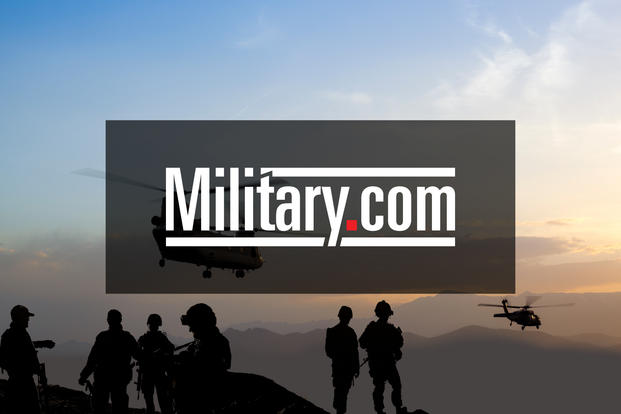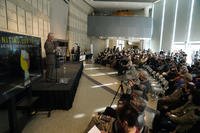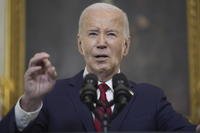President Donald Trump agreed with his generals Monday night to send more troops to Afghanistan but kept under wraps the number to be deployed.
"We will not talk about numbers of troops or our plans for further military activities," he said in unveiling a new strategy for the 16-year-old war in a primetime address to the nation from Joint Base Myer-Henderson Hall next to Arlington National Cemetery in Virginia.
Troops levels in Afghanistan will be based on conditions on the ground -- and the war effort against the Taliban and the offshoot of the Islamic State of Iraq and Syria called Islamic State-Khorasan province, or IS-K, will be significantly stepped up, the president said.
"I will not say when we are going to attack, but attack we will," he said. "The American people deserve a plan for victory," he added, and "in the end we will win."
In not announcing the number of troops in Afghanistan, the president could be applying a policy similar to that already being used in Iraq and Syria, where the so-called Force Management Levels, or numbers of troops officially deployed in the countries, are published by the Pentagon but those on so-called "temporary" assignment are not disclosed.
In the long deliberations on a new strategy for Afghanistan, Trump acknowledged that "my original instinct was to pull out" and abandon the effort that has cost the U.S. nearly $1 trillion and the lives of more than 2,250 troops.
However, Trump said he had come to realize that a "hasty withdrawal" would allow Afghanistan to return to being a sanctuary for terrorists to plot attacks against the U.S. homeland and repeat the mistakes of the Obama administration in withdrawing from Iraq, a strategic misstep that many say resulted in the rise of the Islamic State of Iraq and Syria, or ISIS.
"We cannot repeat in Afghanistan the mistakes our leaders made in Iraq," the president said.
"Nearly 16 years after the Sept. 11 (2001) attacks, the American people are weary of war without victory," he said. "Nowhere is this more evident than in the war in Afghanistan. I share the American people's frustration."
Trump also said he would also loosen the rules of engagement. The new strategy would renew focus on air power and a determined effort to get Pakistan -- a country he repeatedly mentioned during his speech -- to move against Taliban safe havens in the northwestern provinces.
"Pakistan has much to gain with partnering with our effort in Afghanistan," the president said, and "it has much to lose" in harboring the Taliban. "That will have to change and that will change immediately," he said.
The speech appeared to represent a long-term commitment by Trump to a war in Afghanistan that he had criticized before becoming a candidate as not worth the effort.
The president rarely mentioned Afghanistan during the campaign and prior to that he was highly critical of the money and effort being spent on a seemingly endless war.
In 2013, as he considered running for president, Trump tweeted, "We should have a speedy withdrawal" from Afghanistan. "Why should we keep wasting our money -- rebuild the U.S.!"
The previous year, he tweeted, "It is time to get out of Afghanistan. We are building roads and schools for people that hate us. It is not in our national interests."
The prime-time speech was Trump's first nationally televised address since he spoke before Congress in January and followed a week of controversy over his reaction to the racially-charged violence in Charlottesville, Va., in which he appeared to equivocate on condemning white supremacists.
Trump's revised strategy for Afghanistan was the result of a drawn-out process that began in February with the prodding of Army Gen. John Nicholson, commander of U.S. Forces in Afghanistan and the NATO Resolute Support mission.
Nicholson told Congress that the war was at a "stalemate" against the Taliban and a new threat from an offshoot of ISIS called the Islamic State-Khorasan province.
The Army general said he needed a "few thousand" more troops to bolster the counter-terror raids of U.S forces and their train, advise and assist role in shaping the Afghan National Defense Security Forces. Nicholson's request for troops was believed to be in the range of 3,000-5,000.
Currently, about 8,500 U.S. troops are in Afghanistan, along with about 4,500 NATO and coalition troops.
According to a recent report to Congress by the Special Inspector General for Afghanistan Reconstruction, only 57 percent of the districts in the country were under the Afghan government's control as of November 2016 -- a 15 percent decrease from the previous year.
In response to Nicholson's request, Defense Secretary Jim Mattis, who had already been granted authority by Trump to set troop levels in Afghanistan, began drawing up a plan that he said would be delivered by mid-July.
Mattis reportedly was working on a strategy that included about 3,800 more troops, increased air power and a regional approach that would pressure Pakistan into taking action against Taliban safe havens.
After Trump's speech, the defense secretary said the president's strategic guidance followed "a rigorous interagency review."
"I have directed the Chairman of the Joint Chiefs of Staff to make preparations to carry out the president's strategy," he said in a statement. "I will be in consultation with the Secretary General of NATO and our allies -- several of which have also committed to increasing their troop numbers. Together, we will assist the Afghan Security forces to destroy the terrorist hub."
Nicholson had already greatly increased the use of airpower in Afghanistan. In April, he approved the use of the Massive Ordnance Air Blast, or MOAB, bomb -- the largest non-nuclear weapon in the U.S. arsenal -- against IS-K in the Achin district of eastern Nangarhar province.
Overall in April, the U.S. warplanes dropped 460 weapons across Afghanistan, more than the two previous months combined.
Despite the urgency in Nicholson's request, Mattis mid-July timeframe for delivery of the plan kept slipping as Trump wrestled with top White House aides on whether to make a new American commitment to shoring up an Afghan government riddled with corruption and led by President Ashraf Ghani.
At one point last month, White House Chief Strategist Steve Bannon, who left the administration last week, went to Mattis at the Pentagon with a proposal from Erik Prince, founder of the Blackwater security firm, to turn over much of the war effort to mercenaries.
Over the weekend, Mattis told reporters traveling with him in the Mideast that using private contractors to fight the Taliban was under consideration, but he gave no endorsement.
During the White House deliberations on the strategy, including a meeting of top advisors at the presidential retreat at Camp David in rural Maryland over the weekend, Mattis stressed the need for a long-term commitment from Trump.
Mattis reportedly told Trump: "Mr. President, we haven't fought a 16-year war so much as we have fought a one-year war 16 times."
"There were several options" discussed in the White House and at Camp David, Mattis told reporters traveling with him. "The reason we had to get back together was he (Trump) kept asking questions on all of them."
Trump was careful to avoid setting deadlines for the actions by the Afghan government or potential withdrawals of American troops in the future to avoid comparisons with the administration of former President Barack Obama, but a top former Obama administration official made the comparison for him.
Retired Air Force Gen. Michael Hayden, the former CIA Director and director of the National Security Agency, told CNN earlier Monday that he expected Trump's strategy to be "adding a force there to stabilize the situation. This is probably a decision President Obama would have made."
Retired Army Col. Steve Warren, who was on Mattis' staff until recently, also told CNN that "there is value to us committing to stabilize Afghanistan" to avoid having it once again become a base for terrorists to attack the U.S. "The alternative could be much worse," Warren said.
Trump's frustration with Afghanistan mirrored that of President Obama and President George W. Bush before him, and the numerous generals who have been in charge of the war effort, including retired Army Gens. David Petraeus and Stanley McChrystal, and current Joint Chiefs Chairman Gen. Joseph Dunford.
-- Oriana Pawlyk contributed to this report.
-- Richard Sisk can be reached at Richard.Sisk@Military.com.






























